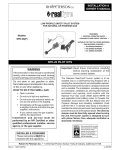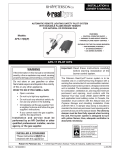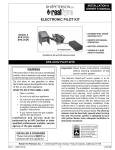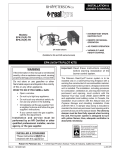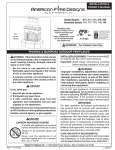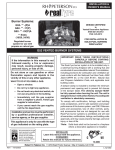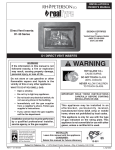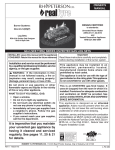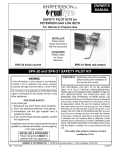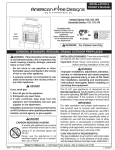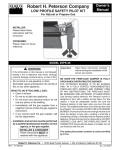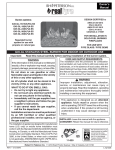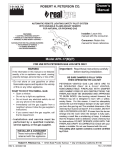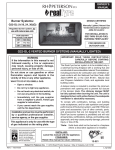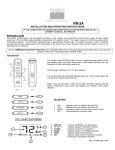Download R.H. Peterson G46-18P Owner`s manual
Transcript
INSTALLATION &
OWNER’S MANUAL
AUTOMATIC REMOTE LIGHTING SAFETY PILOT SYSTEM
WITH VARIABLE FLAME-HEIGHT REMOTE
FOR NATURAL OR PROPANE GAS
FEATURES:
• CONTROL OPERATED ON/OFF •
• VARIABLE FLAME-HEIGHT REMOTE •
• VARIABLE FLAME HEIGHT CONTROL •
Models:
APK-17(M)(P)
• STANDING PILOT •
SUITABLE FOR THE FOLLOWING BURNERS:
• PAN BURNERS (P-SERIES) •
• G4 SERIES BURNERS •
• G45 SERIES BURNERS •
APK-17 PILOT KITS
Important: Read these instructions carefully
before starting installation of the
burner control system.
WARNING
If the information in this manual is not followed
exactly, a fire or explosion may result, causing
property damage, personal injury, or loss of life.
The Peterson Real-Fyre® burner system is to be
installed only in a solid-fuel-burning fireplace with a
working flue constructed of noncombustible material.
Solid fuels shall not be burned in a fireplace where the
unit is installed. The installation, including provisions
for combustion, ventilation air, and required minimum
permanent vent opening, must conform with the
National Fuel Gas Code (ANSI Z223.1/NFPA 54)
and applicable local building codes. In Canada, the
installation must conform with the Natural Gas and
Propane Storage and Handling Installation Code
(CSA-B-149.1). A damper stop clamp is included to
maintain the minimum permanent vent opening and to
prevent full closure of the damper blade. The chimney
damper must be fixed fully opened when burning
the unit. The burner system is designed to burn
with yellow flames; thus, adequate ventilation is
absolutely necessary.
Do not store or use gasoline or other
flammable vapors and liquids in the vicinity
of this or any other appliance.
WHAT TO DO IF YOU SMELL GAS:
• Open a window.
• Do not try to light any appliance.
• Do not touch any electrical switch; do
not use any phone in the building.
• Immediately call the gas supplier from
a neighbor’s phone and follow the gas
supplier’s instructions.
• If you cannot reach the gas supplier,
call the fire department.
Installation and service must be
performed by an NFI Certified or other
qualified professional installer, service
agency, or the gas supplier.
INSTALLER & CONSUMER
These instructions MUST be
retained with this appliance
Robert H. Peterson Co. • 14724 East Proctor Avenue • City of Industry, California 91746
Rev 6 - 1501210930
1
L-A2-256
TABLE OF CONTENTS
GETTING STARTED
IMPORTANT INFORMATION ..................................................................................................................... 3
SPECIFICATIONS......................................................................................................................................... 3
NOTES PAGE ................................................................................................................................................ 4
REPLACEMENT PARTS LIST ..................................................................................................................... 5
INSTALLATION
INSTALLATION............................................................................................................................................ 6
PREPARATION......................................................................................................................................... 6
CONVERTING FOR DIFFERENT GAS TYPE ............................................................................................ 6
INSTALL VALVE ....................................................................................................................................... 6
INSTALL FLAME DIVERTER BRACKET ................................................................................................... 7
INSTALL PILOT ASSEMBLY TO BURNER ................................................................................................. 7
CONNECT TO GAS SUPPLY .................................................................................................................... 8
CONNECT REMOTE RECEIVER (if equipped)........................................................................................... 9
HEAT SHIELD PLACEMENT .................................................................................................................... 9
DECORATIVE MEDIA REPLACEMENT.................................................................................................... 9
USE, CARE, & SERVICE
LIGHTING INSTRUCTIONS - 17 SERIES ............................................................................................... 10
LIGHTING THE PILOT .......................................................................................................................... 10
REMOTE LIGHTING (if equipped) .......................................................................................................... 10
MANUAL LIGHTING .............................................................................................................................. 11
SHUTTING DOWN ................................................................................................................................. 12
PILOT BURNER CHECK/ADJUSTMENT ................................................................................................ 12
REMOTE OPERATING INSTRUCTIONS - 17 SERIES ........................................................................... 12
ORIENTATION ....................................................................................................................................... 12
FLAME HEIGHT .................................................................................................................................... 12
TROUBLESHOOTING ............................................................................................................................... 13
SYNCING THE REMOTE SYSTEM ......................................................................................................... 13
SYNCING THE REMOTE SYSTEM .......................................................................................................... 13
WARRANTY ............................................................................................................................................... 14
Rev 6 - 1501210930
2
L-A2-256
IMPORTANT INFORMATION
CHECK TO BE SURE THAT THE PROPER FUEL GAS IS BEING USED WITH THIS PILOT KIT.
The installation, including provisions for combustion and ventilation air, must conform with local codes, or in the
absence of local codes, with the National Fuel Gas Code (ANSI Z223.1/NFPA 54).
This component and its individual shutoff valve must be disconnected from the gas-supply piping system when
testing at pressures that exceed 1/2 psig. This is accomplished by closing the gas-supply line valve.
This component must be isolated from the gas-supply piping system by closing its individual manual shutoff
valve during any testing of the gas-supply system at test pressures up to and including 1/2 psig.
A fireplace screen must be in place when the gas burner system is in operation. Unless other provisions for
combustion air are provided, the screen shall have an opening(s) for introduction of combustion air.
WHEN GLASS FIREPLACE ENCLOSURES (DOORS) ARE USED, OPERATE THE BURNER SYSTEM WITH
THE GLASS DOORS FULLY OPEN; BOTH SIDES IF THE FIREPLACE IS A SEE-THROUGH TYPE.
This appliance may be installed in an aftermarket, permanently located, manufactured (mobile) home where not
prohibited by local codes. Installation of appliances designed for manufactured homes or mobile homes must
conform with Manufactured Home Construction and Safety Standard, Title 24 CFR, Part 3280 in the U.S.; or with
CAN/CSA Z240 MH in Canada; or with ANSI/NCSBCS A225.1/NFPA 501A, Manufactured Home Installations
Standard when such as standard is not applicable.
Do not use this appliance if any part has been underwater. Immediately call a qualified service technician to
inspect the appliance and to replace any part of the control system and any gas control that has been underwater.
TO PREVENT VALVE DAMAGE AND FAILURE:
IT IS CRITICAL THAT THE HEAT SHIELD BE PLACED CORRECTLY OVER THE VALVE PRIOR TO
OPERATION.
KEEP SAND GRANULES, LAVA GRANULES, AND ALL FOREIGN OBJECTS AWAY FROM THE PILOT
ASSEMBLY,VALVE ASSEMBLY, AND HEAT SHIELD DURING MEDIA PLACEMENT AND AT ALL TIMES.
SPECIFICATIONS
Minimum firebox dimensions required for burner system
(with APK valve attached):
Burner size
Min. Firebox Dimensions
Center Width *
Depth
Height
16/19"
30"
11"
18"
18/20"
31"
14"
18"
24"
35"
14"
18"
30"
41"
15"
18"
36"
47"
16"
18"
42"
53"
16"
18"
48"
59"
16"
18"
54"
65"
16"
18"
60"
71"
16"
18"
Model
APK-17
BTUs
Nat.
L.P.
100 k
200 k
Table 2 - Maximum BTUs
Center width
Depth
* This required width allows for centering of the log set.
Table 1 - Minimum Firebox Dimensions
Rev 6 - 1501210930
3
L-A2-256
NOTES PAGE
Please use this page to record any information that you may want to have at hand.
Rev 6 - 1501210930
4
L-A2-256
APK-17 REPLACEMENT PARTS LIST
8
2
Wire harness to
remote receiver
(if equipped)
4
6
3
1
5
Note: Photos not to scale
7
Item Description
Rev 6 - 1501210930
Part No.
Qty.
SV-37
1
PAC-1NAT
PAC-1LP
1
1
1.
Control valve
2.
or
Pilot assembly (natural)
Pilot assembly (propane)
3.
Flame diverter bracket
SH-1
1
4.
Valve heat shield
HS-41
1
5.
Control knob
KNOB-9
1
6.
Remote kit (if equipped)
VR-1A
1
7.
Extension handle
EH-14
1
8.
or
Nat. gas orifice
L.P. gas orifice
PBO-20
PBO-10
1
1
5
L-A2-256
INSTALLATION
This safety pilot system must be installed by a qualified professional service technician. Instructions
must be followed carefully when installing to ensure proper performance and full benefit from the
burner system and safety pilot system.
These instructions must be used as a supplement to the instructions supplied with the R.H. Peterson burner
system. Follow the burner system instructions and make adjustments as appropriate for the addition of a
safety pilot system. Use gas pipe sealing compound that is resistant to all gasses (or Teflon tape) and apply
to all male pipe connections. DO NOT apply pipe sealing compound to any flare connections. Make sure that
all connections are tight.
The valve system is shipped pre-assembled for easy
installation onto the burner pan.
Note: Installation is easier when done outside of the
fireplace.
Pilot
orifice
PREPARATION
If the burner that the valve system is to be added to is
already installed; remove all decorative media, set aside to
be reinstalled later, and disconnect the flex connector and
adapter from the burner pan (using the instructions that
came with the original burner).
Insulation
pad
Fig. 6-1 Pilot conversion (only if applicable)
CONVERTING FOR DIFFERENT GAS TYPE
CAUTION: Check to be sure this pilot kit is designed
and labeled for the type of gas (natural or
propane gas) supplied to the fireplace.
The safety pilot kit may require a pilot orifice conversion.
Replace the existing gas orifice with the opposite gas
orifice (contained in the envelope marked "L.P. GAS" or
"NAT GAS") by carefully removing the pilot gas supply line.
Re-attach the pilot gas supply line to the pilot when done.
Reference Fig. 6-1.
CAUTION: During any conversions, all components must
be set/converted for the appropriate gas type
(i.e. burner orifice, regulator, etc.). Contact
your dealer and a qualified professional
service technician.
Install shown on
a G45 pan
Attach the valve to the
air mixer/fuel injector by
rotating the burner pan.
Burner
pan
Fuel injector
or air mixer
Valve
INSTALL VALVE
1. Apply gas pipe sealing compound (or Teflon tape) to the
male end of the fuel injector or air mixer on the burner.
2. Install the valve to the fuel injector or air mixer by
screwing the pan into the valve (Fig. 6-2). Take care not
to damage the attached pilot assembly when rotating the
burner pan. Be sure all connections are tight, however
do not overtighten to prevent damage to the valve.
(design may vary)
Fig. 6-2 Install valve
SIDE VIEW OF VALVE ON PAN
3/4"
minimum
clearance
Important: Ensure the bottom of the control knob is
at least 3/4" above the floor. See Fig. 6-3.
Fireplace floor
Fig. 6-3 Ensure knob clearance
Rev 6 - 1501210930
6
L-A2-256
INSTALLATION (Cont.)
INSTALL FLAME DIVERTER BRACKET
For installation on G4/G45 burners only. When properly
installed onto the burner pan, the flame diverter bracket
will promote quicker ignition and protect the safety control
system from overheating.
REAR WALL
BURNER
Burner
pan
PAN
Note: You must first install the flame diverter bracket
before installing the pilot/igniter assembly.
1. Place the flame diverter bracket over the side edge
of the burner pan, near the location the safety control
system pilot bracket will be attached. It should be
placed approximately 1-1/4" from the rear wall of
the burner pan (see Fig. 7-1).
2. Tap the bracket lightly with a rubber mallet to secure
it in place.
INSTALL PILOT ASSEMBLY TO BURNER
1
21-1/2
/4"
FLAME
DIVERTER
Flame
BRACKET
diverter
bracket
Fig. 7-1 Install diverter bracket (if applicable)
Fasten pilot
assembly to
burner pan
CAUTION: Use only the pilot assembly pre-assembled
with this kit. Never substitute with an existing
pilot.
CAUTION: Do not kink or damage the pilot supply line
and thermocouple tube. Do not unscrew the
gas line from the valve.
1. The pilot assembly comes with two Phillips screws
installed on the long side of the pilot bracket. Remove
the screws and use them to fasten the pilot assembly
to the burner pan using the pre-drilled holes in the
pan (see Fig. 7-2 and Fig. 7-3).
(screw from
inside)
Fig. 7-2 Install pilot assembly
Note: Ensure the insulation is properly in place between
the pilot bracket, burner pan, and pilot assembly.
Screw from the inside of burner pan.
2. Ensure the pilot supply line and thermocouple tube
are bent in a similar manner as shown in Fig. 7-3 to
prevent damage / unsafe operation, and to allow for
proper heat shield placement. Maintain this orientation
at all times.
WARNING: Keep the pilot assembly clear at all
times. Never cover any part of the pilot
assembly.
Properly bend
line and tube
Fig. 7-3 Proper line and tube orientation
Rev 6 - 1501210930
7
L-A2-256
INSTALLATION (Cont.)
CONNECT TO GAS SUPPLY
To connect the valve to the gas supply, the flex connector
kit and component parts will be needed, which are included
with the burner system. Refer to the PARTS LIST in the
instructions supplied with the burner to identify the key
parts needed.
To large adapter /
gas supply
Attach small adapter
& flex connector to
nipple on valve
1. MAKE SURE THE FIREPLACE GAS SUPPLY IS
TURNED OFF.
2. Locate the gas-supply stub inside the fireplace and
remove the cap, if attached.
CAUTION:
When removing the cap, make sure the stub
does not turn, loosening the connection inside
the wall.
3. Attach the small adapter (included with burner flex
connector kit) to the gas nipple on the control valve
using a pipe compound resistant to all gasses.Tighten
securely. Then attach one end of the connector to the
small adapter. Tighten securely. See Fig. 8-1.
Fig. 8-1 Install flex connector to valve
4. Place the burner system in the fireplace. Center the
burner in the fireplace.
5. Be sure gas to the fireplace is off. Attach the large
adapter (included with burner flex connector kit) to
the gas-supply stub using a pipe compound resistant
to all gasses. Tighten securely. Then attach the open
end of the flex connector to the large adapter. Tighten
securely.
6. LEAK TEST: Turn on the fireplace gas supply, and test
at all connections for leaks using the appropriate soapy
water solution. If bubbles appear, a leak is present.
Turn off the gas and tighten at all connections. Repeat
until no leaks are present. If a leak persists, turn off
the gas supply and contact the local gas company
or dealer. NEVER USE A FLAME TO CHECK FOR
LEAKS.
7. Follow the instructions supplied with the Peterson
burner system for any additional requirements
regarding specific burner setup and placement.
Rev 6 - 1501210930
8
L-A2-256
INSTALLATION (Cont.)
CONNECT REMOTE RECEIVER (if equipped)
Note: Discard the black wires that come with the remote
receiver.
1. Install the provided batteries in the remote transmitter
and receiver.
6" min.
2. Place the receiver as far from the burner system as
possible (see Fig. 9-1).
Note: Place the receiver a minimum of 6" from the
burner/flame.
3. Place the plastic cover over the remote receiver
with the open side facing front to allow access to the
receiver controls (see Fig. 9-1).
4. Ensure the remote receiver wire harness is properly
connected to the valve as shown in Fig. 9-2.
HEAT SHIELD PLACEMENT
TO PREVENT VALVE DAMAGE AND FAILURE:
IT IS CRITICAL THAT THE HEAT SHIELD BE
PLACED CORRECTLY OVER THE VALVE PRIOR
TO OPERATION.
TO PREVENT OVERHEATING THE VALVE:
Cover the valve with the heat shield as shown in Fig. 9-3
and Fig. 9-4. It should rest flat above the valve.
Keep the area above and below the heat shield clear
of decorative media or any other objects at all times.
Receiver
(w/ plastic cover)
Fig. 9-1 Place receiver away from burner
(from
remote
receiver)
Ensure connection
Wire
harness
Valve
Fig. 9-2 Ensure harness connection
HEAT SHIELD
MUST BE
PROPERLY
PLACED
Important: E n s u r e t h e p i l o t s u p p ly l i n e a n d
thermocouple tube do not interfere with
heat shield placement.
Important: Keep sand granules, lava granules, and all
foreign objects away from the pilot assembly,
valve assembly, and heat shield during
media placement and at all times.
APK-17 installation is complete at this point. Ensure ALL
information in this manual is followed to ensure proper
operation.
Fig. 9-3 Place heat shield
DECORATIVE MEDIA REPLACEMENT
Refer to the burner instructions for proper placement of
decorative media.
Important: Keep sand granules, lava granules, and all
foreign objects away from the pilot assembly,
valve assembly, and heat shield during
media placement and at all times.
Fig. 9-4 Heat shield properly placed
Rev 6 - 1501210930
9
L-A2-256
LIGHTING INSTRUCTIONS - 17 SERIES
FOR YOUR SAFETY READ BEFORE LIGHTING
WARNING: If you do not follow these instructions exactly, a fire or explosion may result causing property
damage, personal injury or loss of life.
A. Use only your hand to push in or turn the gas control knob. Never use tools. If the knob will not push in or turn
by hand, don't try to repair it. Call a qualified professional service technician. Excessive force or attempted
repair may result in fire or explosion.
B. BEFORE OPERATING, smell all around the appliance area for gas. Be sure to smell next to the floor
because some gas is heavier than air and will settle on the floor.
WHAT TO DO IF YOU SMELL GAS
• Do not light any appliance.
• Do not touch any electric switch; do not use any phone in your building.
• Immediately call your gas supplier from a neighbor's phone. Follow the gas supplier's instructions.
If you cannot reach your gas supplier, call the fire department.
C. The burner system has a pilot that can be lit by hand using a match or long-necked lighter. When lighting
the pilot, follow these instructions exactly.
D. Do not use this appliance if any part has been under water. Immediately call a qualified service technician
to inspect the appliance and to replace any part of the control system and any gas control which has been
under water. Attempted operation may result in fire or explosion resulting in property damage, personal
injury or loss of life.
LIGHTING THE PILOT
1. Locate the valve on the side of the unit. Push in the gas
control knob slightly and turn clockwise to OFF (Fig. 10-1).
Note: The control knob cannot be turned from PILOT to
OFF unless the knob is pushed in slightly. Do not
force.
Allow five (5) minutes for any gas in the unit to dissipate.
IF YOU SMELL GAS, SEE STEP B ABOVE. If you don’t
smell gas, go on to step 2.
2. Turn the control knob counterclockwise to PILOT (Fig.
10-1). Push the control knob firmly and fully in and
hold. Hold a long fireplace match or lighter near the
thermocouple to light the pilot. Continue to hold the
control knob in for approximately 60 seconds after the
pilot is lit, then release the knob. The pilot will remain lit.
1. Turn knob clockwise
to OFF prior to lighting
the pilot.
2.
Tu r n k n o b
counterclockwise to
PILOT position. With
match ready, press
knob in and hold for
60 seconds while
lighting pilot.
WARNING: If the pilot fails to light repeat steps 1 and 2.
If the pilot fails to light after several tries, turn the control knob
to OFF and contact a qualified professional service technician.
Fig. 10-1 Control knob detail (OFF, PILOT)
REMOTE LIGHTING (if equipped)
Note: If the remote does not function, and batteries with
an adequate power level are installed, refer to the
SYNCING THE REMOTE section.
Note: Step 1 may not be required if previously done during
an earlier lighting.
1. Ensure the pilot is burning. Then locate the 3-position
switch on the remote receiver (see Fig. 10-2), and slide
the switch to the REMOTE position.
10
LEARN
OFF REMOTE
ON
Fig. 10-2 Remote receiver detail (REMOTE)
LIGHTING INSTRUCTIONS - 17 SERIES (cont.)
2. Locate the remote transmitter and press and hold the
ON/HI button (see Fig. 11-1). The ignition sequence
will begin.
Note: Continue holding the button to increase the flame.
A click will be heard when max flame height is
reached.
Note: Upon initial use or after an extended period of no
use, the ON/HI button may have to be pressed for
up to 3 seconds prior to functioning.
ON/HI
LO/OFF
The remote receiver will emit an audible "beep";
then the valve will automatically open and the burner
will light. Adjust to the desired setting(s) with the
remote transmitter. See the REMOTE OPERATING
INSTRUCTIONS section for details.
Note: The ignition sequence will take approximately 5
seconds.
WARNING: If the burner fails to light within 5 seconds,
press and hold the OFF button on the
remote transmitter and/or slide the switch
to the OFF position. Allow five (5) minutes
for any gas in the unit to dissipate, then
repeat steps 1 and 2 above. IF YOU SMELL
GAS, SEE STEP B AT BEGINNING OF
LIGHTING INSTRUCTIONS.
If the burner fails to light after several tries, turn all system
components to OFF and contact a qualified professional
service technician.
Fig. 11-1 Remote transmitter detail
LEARN
OFF REMOTE
ON
Fig. 11-2 Remote receiver (OFF for Manual Light)
MANUAL LIGHTING
1. Ensure the pilot is burning. If equipped, locate the
3-position switch on the remote receiver (see Fig. 11-2),
and slide the switch to the OFF position.
2. Turn the gas control knob counterclockwise to ON
(Fig. 11-3) to ignite the burner. The valve will open and
the burner will light.
For Manual
Lighting, turn knob
counterclockwise to
ON position.
Note: The ignition sequence will take approximately 5
seconds.
WARNING: If the burner fails to light within 5 seconds,
turn the control knob clockwise to
PILOT. Allow five (5) minutes for any
gas in the unit to dissipate, then repeat
step 2 above. IF YOU SMELL GAS, SEE
STEP B AT BEGINNING OF LIGHTING
INSTRUCTIONS.
If the burner fails to light after several tries, push in the
control knob slightly and turn clockwise to OFF, and contact
a qualified professional service technician.
11
Fig. 11-3 Control knob detail (ON)
LIGHTING INSTRUCTIONS - 17 SERIES (cont.)
SHUTTING DOWN
Pilot adjustment screw
MAIN BURNER ONLY (pilot will remain lit):
Thermocouple
For remote shut down, press and hold the LO/OFF button
on the remote transmitter until the burner shuts off. If remote
is unavailable, slide the switch on the receiver to the OFF
position. For manual shutdown, turn the control knob
clockwise to PILOT.
BURNER AND PILOT (total shutdown):
If you do not plan on using your burner system for an
extended period (one week or more), you may extinguish
the pilot. This will conserve energy and save you money.
PILOT
VALVE
Fig. 12-1 Pilot adjustment detail
Push in the control knob slightly and turn clockwise to OFF.
PILOT BURNER CHECK/ADJUSTMENT
With the pilot burner lit and the control knob in the pilot
position, check the pilot system for proper flame size and
appearance (see Fig. 12-1). The pilot adjustment screw is
located on the front of the gas valve (see Fig. 12-1). Using a
small flat head screwdriver, adjust the pilot screw to properly
size the flames. Turning the screw clockwise will lower the
flames, and turning it counterclockwise will raise them. Be
careful not to back the screw out of its threads.
The pilot flame should be a quiet, soft blue flame with yellow
tipping that encircles the thermocouple tip.
REMOTE OPERATING INSTRUCTIONS - 17 SERIES
ORIENTATION
Note: If the remote does not function, and batteries with
an adequate power level are installed, refer to the
SYNCING THE REMOTE section.
Prior to remote transmitter use, light the appliance per the
REMOTE LIGHTING section. Familiarize yourself with the
transmitter buttons, as illustrated in Fig. 12-2.
ON/HI
LO/OFF
Identify the transmitter buttons:
• ON/HI BUTTON: This button turns the burner ON (when
the pilot is lit), and increases the flame height.
• LO/OFF BUTTON: This button decreases the flame
height and turns the burner OFF (pilot will remain lit).
FLAME HEIGHT
The flame height may be adjusted via the remote transmitter.
Press and hold the ON/HI button to increase the flame
height. Press and hold the LO/OFF button to decrease the
flame height. A click will be heard when the max/minimum
setting is reached.
Note: Continuing to hold the LO/OFF button will turn off
the burner. The pilot will remain lit.
12
Fig. 12-2 Remote transmitter detail
TROUBLESHOOTING
PROBLEM
CAUSE
SOLUTION
a. Obstruction in pilot gas supply or
pilot gas-supply line is kinked
a. Clear out obstruction. Replace pilot gassupply line if kinked
b. Inadequate gas supply
b. Have gas pressure checked by installer
or gas supplier
c. Air in line
c. Air should clear; attempt to relight
a. Thermocouple connection to valve
either too tight or too loose
a. Thermocouple should be finger tight and
then 1/8" turn with a wrench
b. Bad thermocouple
b. Replace thermocouple
3. Log set extinguishes
a few minutes after
lighting
a. Inadequate gas supply causes
pilot flame to reduce after burner
lights
a. Using pilot adjustment, increase gas to
pilot. Pilot flame must be in contact with
the thermocouple tip.
4. Log set extinguishes
after burning for some
time (approximately 10
minutes to 1 hour)
a. Thermocouple has overheated;
glass doors are closed
a. Be sure glass doors are open during
operation
b. Thermocouple has overheated;
insulation pad is not in place
b. Be sure that the insulation pad is in place
between the burner pan and the pilot
bracket
c. Thermocouple has overheated;
burner flames are heating the
thermocouple cold junction
c. Be sure the pilot assembly and the flame
diverter are in their proper position.
Re-arrange logs so that flame is not
deflected to the thermocouple.
a. Valve over heated
a. Ensure that the valve heat shield is
properly placed and no gas leaks are
present at the valve gas fittings
1. Pilot will not light
2. Pilot will not stay lit after
releasing knob
5. Valve will not turn "OFF"
with remote
b. Low batteries
b. Replace batteries in remote receiver
SYNCING THE REMOTE SYSTEM (IF APPLICABLE)
SYNCING THE REMOTE SYSTEM
Ensure the burner system is off and completely cool.
Locate the 3-position switch on the remote receiver and
slide it to the REMOTE position. Next press the LEARN
button and release. See Fig. 13-1. A beep will be heard.
Then press and hold the ON/HI button on the remote
transmitter; a series of beeps should be heard. The
remote system is now synced. Refer to the LIGHTING
INSTRUCTIONS to test.
LEARN
OFF REMOTE
ON
Fig. 13-1 Remote receiver sync detail
13
WARRANTY
PETERSON VENTED DECORATIVE GAS APPLIANCE
LIMITED WARRANTY
Robert H. Peterson Co. ("RHP") warrants your Real Fyre® vented decorative gas appliance to be free from defects in material and
workmanship.
Peterson vented ceramic refractory gas logs are warranted for as long as you own them (lifetime).
Peterson vented burner assemblies are WARRANTED for TEN (10) YEARS. Peterson vented outdoor stainless-steel burner
assemblies are warranted for FIVE (5) YEARS.
Peterson glass, gems, nuggets, and fiber-ceramic blend gas logs are warranted for FIVE (5) YEARS.
SPK-26 controls are warranted for THREE (3) YEARS.
APK-17 controls (including -17 valve) are warranted for TWO (2) YEARS.
All other Peterson valves, pilots, and controls are warranted for ONE (1) YEAR (excluding batteries).
A COPY OF YOUR SALES SLIP FOR PROOF OF PURCHASE IS REQUIRED
This warranty applies to the original purchaser for products which are installed in the United States or Canada and which are operated and maintained
as intended for single family residential usage. This warranty is valid only with proof of purchase, shall commence on the date of purchase, and shall
terminate (both as to original and any replacement products) on the anniversary date of the original purchase of the product stated on the above schedules.
This warranty covers defects in material and workmanship. This warranty does not cover parts which become defective as a result of negligence, misuse,
use not in compliance with the Owner’s Manual/Installation Instructions, accidental damage, improper handling, improper storage, improper installation,
lack of required routine maintenance (as specified in the Owner’s Manual/Installation Instructions), electrical damage, local gas impurities or failure to
protect against combustibles. Product must be installed (and gas must be connected) as specified in the Owner’s Manual/Installation Instructions by
a qualified professional installer. Modifications to products which are not specifically authorized will void this warranty. Accessories, parts, valves,
remotes, etc. when used must be Peterson products or this warranty is void. Warrantied items will be repaired or replaced at Peterson’s sole discretion.
This warranty does not apply to rust, corrosion, oxidation, or discoloration unless the affected part becomes inoperable.
This warranty does not cover labor or labor related charges, except as provided by separate specific written programs from the Peterson Co. All repair
work must be performed by a qualified professional service person and requires prior approval of Peterson.
Peterson may require the defective product or part to be returned to the factory to determine the cause of failure. Peterson will pay freight charges if
the product or part is determined to be defective. This warranty does not cover breakage in shipment from our (Independent) distributor to its customer
if the damage is determined to have occurred during that shipment.
This warranty specifically excludes liability for indirect, incidental, or consequential damages. Some states and provinces do not allow the exclusion
or limitation of incidental or consequential damages, so the above exclusion may not apply to you. This warranty gives you specified legal rights, and
you may have other rights that vary from state to state or province.
For additional information regarding this warranty, or to place a warranty claim, contact the R. H. Peterson dealer where the product was purchased.
TO REGISTER YOUR PRODUCT ONLINE GO TO: WWW.RHPETERSON.COM,
AND CLICK ON PRODUCT REGISTRATION. THANK YOU FOR YOUR PURCHASE.
Quality Check
Date:_________________
Leak Test:
________________ Burn Test: _________________ Gas Type:
Inspector:
________________
Robert H. Peterson Co. • 14724 East Proctor Avenue • City of Industry, CA 91746
14
Nat. / L.P.














